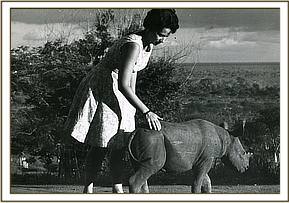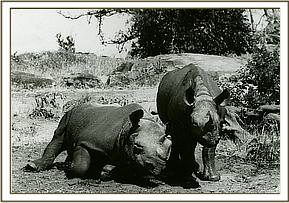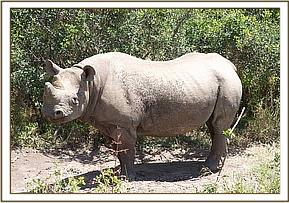Orphaned Rhino Pushmi was born near a main tourist circuit in Tsavo East National Park way back on 9th October, 1973 and abandoned immediately after birth when his Rhino Mother was disturbed by a passing Tourist Van. Instantly she fled, leaving a wet bundle still enveloped in foetal tissue lying on the ground. Unsure that the mother would return to reclaim her calf, and fearful that hyaenas and vultures would seal his demise, the Tourists insisted that he be retrieved and delivered to Tsavo East Headquarters where Warden David Sheldrick and his wife, Daphne, were already known for rearing orphaned wildlife, including rhinos.


We called the newborn rhino baby Pushmi because shoving and pushing was his favourite pastime as an infant, in between galloping around and executing little pig jumps. He thrived on Nestles Lactogen baby formula milk, gaining a kilo every passing day. At the time another orphaned rhino named Stroppie was also part of the what had become known as The Big Orphans, browsing the Park each day amongst several orphaned Elephants of varying age and size, an orphaned zebra named Punda, who was Stroppies best friend, and several orphaned buffaloes all under the watchful eye of the orphaned Elephant Matriarch named Eleanor who viewed this somewhat motley herd as her family. A couple of human Attendants went along with them to ensure that they were not corrupted by handouts of junk food from passing tourists. Each evening Eleanor and her brood traipsed back up the hill to their Night Shelters where cut fodder was provided for their nocturnal snacking.

In 1976 David Sheldrick was due to be transferred from Tsavo to Nairobi to head the new Wildlife Conservation & Management Departments Planning Unit. Unhappily this Government department which had replaced the original Kenya National Parks Board of Trustees, was rapidly becoming known as the Wildlife Corruption and Poaching Department, in-house poaching of both elephants and rhinos being perpetrated by the very people employed to protect them. By now we had also learnt that the integration of an orphaned rhino into a territorially established wild rhino population was a complicated procedure which entailed three years of walking the newcomer round the dung-piles and urinals of the resident community, for it to become accepted as a rightful member. Rhinos are fiercely intolerant of strange intruders into their domain, their daily lives entirely governed by chemistry and scent. We were fearful for the survival of Stroppie and Pushmi if left behind, so David arranged to move them to Solio Ranch near Nanyuki in Northern Kenya, where the owner Court Parfet, had fenced off 25 square miles of his cattle ranch as a birthday gift for his French conservation minded wife, Claudie. He had stocked it with indigenous wild animals, amongst which were about half a dozen Black Rhinos, one another earlier Ex Orphan named Reudi the one who had taught us the complexities of rhino reintegration. Solio was a paradise in miniature echoing the diversity and wildlife splendour of earlier times. A crystal clear stream meandered through a Yellow Fever Acacia forest and extensive reedbeds, where aquatic Coypu lived and crowned cranes and other water birds nested and raised their young. Open grassy glades, during the rains filled with wild flowers, interspersed shrubbery thickets of delicately scented bushes, all against the backdrop of magnificent Mt. Kenya. Stroppie and Pushmi occupied a 50 acre fenced paddock abutting the main Sanctuary, and it was hoped that proximity would enable them to eventually become integrated into the main rhino community next door. However, this was not to be, because after three attempts ended in Pushmi being almost annihilated by the dominant male, (which, ironically happened to be Ex Tsavo orphan Reudi), Mrs. Parfet said No More and both rhinos were returned to their original enclosure. By then Pushmi was a magnificent bull sporting a 3 ft. tapered horn on the end of his nose while Reudi went on to father most of the rhinos that have repopulated areas from whence they had been annihilated by poaching for their lucrative horns.


So, he and Stroppie lived out their lives there, Pushmi established at one end of the paddock, and Stroppie at the other, responding to their names to come and enjoy a regular handout of sugarcane. They became iconic symbols whom Mr. Parfet enjoyed sharing with important guests. One would have been forgiven for not knowing that these two had been brought up together for whenever they met up, they huffed, puffed, snorted and indulged in a charging ritual as though combatants. Such interaction is, however, n integral part of rhino existence, and something they enjoy. Whenever Stroppie came into season, they mated, but sadly no baby resulted, since rhino males must be dominant in order to be fertile, and Pushmi remained subservient to his dominant neighbours whom he had not been able to conquer to get his hormones going. Stroppie, three years older than Pushmi lived to the ripe old rhino age of 40 dying in 2010 peacefully, as she should, in her sleep. She had enjoyed a sheltered and happy life at Solio in her 50 acre paddock with Pushmi as company, and which was permeated with the scent of many others next door. By then they had multiplied to over 70 Blacks and even more Whites of original stock imported from South Africa. (White Rhinos are not indigenous in Kenya within living memory, although fossil remains have been found here, and they used to occur in neighbouring Uganda, Congo and the Sudan). Pushmi lived on, though minus his magnificent horn which had to be removed for his own safety. By now the poaching of rhinos was an ever increasing threat denuding their numbers in their National Park bastions and spreading to the Private Ranches such as Solio. On the 4th June 2012 - Daphne's 78th birthday a sad phone message relayed the tragic news that Pushmi had also died the victim of spear wounds which had penetrated his body causing peritonitis, his tiny stub of a horn still intact, so at least the thug who killed him was denied that prize. He was 38 years old, and as such possibly the oldest living black rhino on the African Continent, killed for the myth held by Far Eastern races that rhino horn is a cure-all and an aphrodisiac, despite being simply compressed hair the same substance as a finger nail. If the Chinese, Vietnamese, Thais and Indonesians chewed their fingernails, they wouldn't have to cut them, and would be ingesting an identical substitute. But, how does one change the mind-set of 2 billion people who through ignorance threaten the very existence of this iconic species who has trodden the earth unchanged for 60 million years. As such, in terms of Nature, rhinos are perfect for the function for which they were designed within the environment. Rest in Peace dear Hoshy. You were deeply loved by many, not least by your human foster Mum who took you into care as a 60 lb. bundle still enveloped in foetal membranes all those years ago. Dame Daphne Sheldrick thanks the Parfets and Solio for giving him and Stroppie protection, shelter and a good life for so many years.








